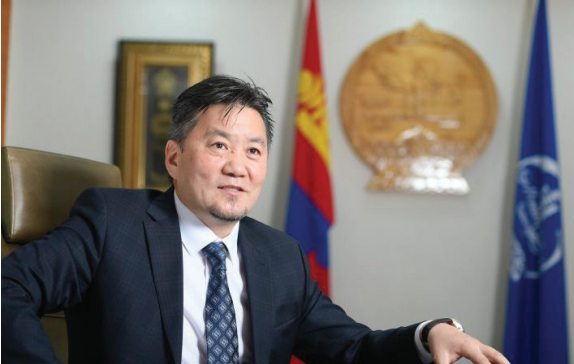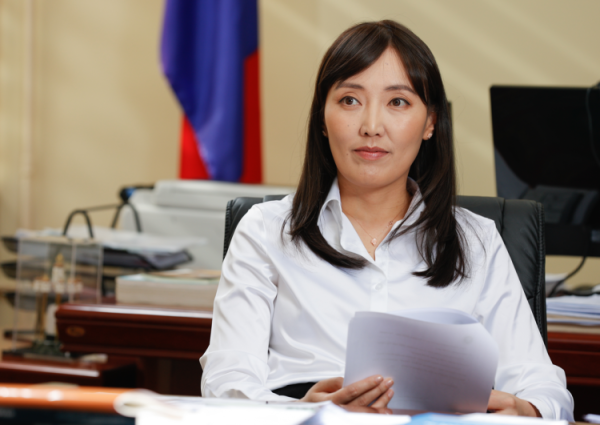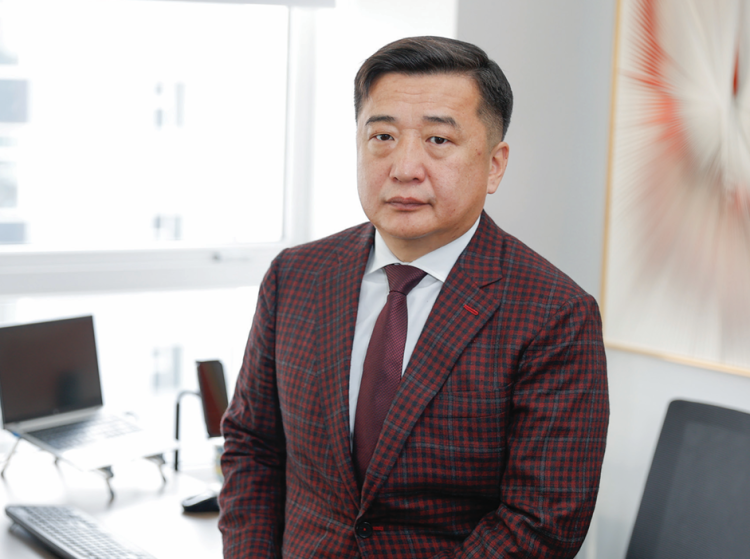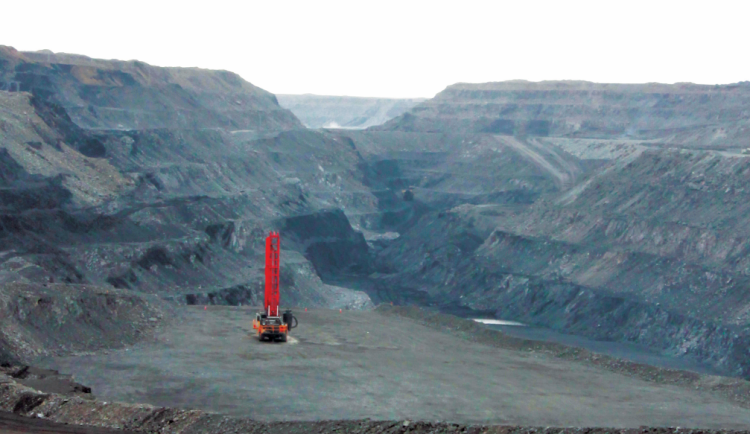 Our team member at Mining Insight Bayartogtokh.B interviewed the Governor of the Bank of Mongolia Mr. Lkhagvasuren.B
Our team member at Mining Insight Bayartogtokh.B interviewed the Governor of the Bank of Mongolia Mr. Lkhagvasuren.BLet’s start our interview on changes in the economic and business environment compared to when you first took the job.
After being appointed as the Governor of the Bank of Mongolia in late 2019, I took three major tasks and measures as a matter of urgency that were announced to the media and the Parliamentary Standing Committee. Mongolia was included in the “gray” list of the Financial Action Task Force (FATF) in October 2019. We’ve fulfilled their recommendations in a short time to steer clear of the list first. Also, the successful completion of the International Monetary Fund’s (IMF) three-year program Extended Fund Facility (EFF), which has been stalled since 2017, was another priority to maintain economic recovery and stabilize macroeconomic indicators. We’ve achieved certain results so far. For example, Mongolia was delisted from the “gray” list in less than a year. The IMF program has been completed. By deciding to continue the banking sector reform individually, Mongolian banks are now preparing for IPOs and will soon be under public scrutiny as a result. Although we’ve accomplished a lot, there were several major challenges. The impact of the global pandemic that started in 2020, the follow-up measures, such as a quarantine regime, transportation, and logistics deadlocks, and border delays, still lingers to some degree. As Mongolia prepares to recover from the pandemic, geopolitical tensions are rising with ensured economic and financial sanctions, creating another challenge. The last two years have been a year of great shock around the world, challenging not only the economy but in all respects, as no one can predict the pandemic and geopolitical tensions. In 2022, many countries will face common challenges such as high inflation, economic stagnation, and supply chain disruptions. However, these challenges have brought about significant changes in human thinking and development, as well as significant changes in people’s working methods, lifestyles, business practices, and government policies.
Why did the Central bank cut the economic growth outlook, at roughly half the pace of its last forecast?
2022, but we lowered our forecast to 2.4% in our April Inflation Report. Firstly, economic activity was lower than anticipated while external risks increased sharply. For example, the spread of COVID-19 in China, the effects of quarantine, and border restrictions continue to make situations worse. The RussiaUkraine geopolitical tension has also come as an unexpected shock. These shocks negatively affect consumption, investment, and foreign trade through market participants’ expectations and links to foreign markets. From a manufacturing perspective, delays in export output and imports of domestic products pose a risk of slowing sector growth. Mongolia’s characteristics also have a significant impact. 80-90 percent of our exports go to our southern neighbor China, while 35 and 30 percent of our imports come from China and Russia. Due to restrictions at the southern border and ports, coal exports remain below average and import disruption persists. Also, rising prices and restrictions on the import of fuel and other industrial products from the northern neighbor imposed by international sanctions are exacerbating economic vulnerabilities. As for the rest of the world, economic growth is expected to slow due to the pandemic and geopolitical shocks. Leading international organizations to forecast Mongolian economic growth to be around 5-6 percent in 2022 a year ago, but now they have lowered their growth outlook to 1-3 percent.
How is the Bank of Mongolia assessing the current economic situation and what are the policies are you implementing?
Our economy is not immune to global shocks. In some cases, the negative effects are felt more strongly. The Bank of Mongolia has always pursued a policy aimed at achieving its legal objectives. This means that policies and measures are being taken to ensure price stability and maintain financial stability. However, the Bank of Mongolia has to make very complex policy choices and decisions. This isn’t the case for our central bank only. Central bankers around the world are facing a difficult choice, which is observed in several global reports. At a time when inflation is high, it is difficult to decide whether to raise interest rates to fight inflation or to keep benchmark rates at current levels to help the economy recover from the pandemic. When the inflation was low, our focus was on overcoming the pandemic and reviving the economy. But now, with inflation relatively high, mainly due to imported goods and the higher global price of oil, decisive policy action is being taken. The Monetary Policy Committee decided to increase the benchmark rate by 2.5 percentage points to 9.0 percent. The banking sector reform plan is still effective with a special focus on strengthening the sector’s stability. Concessions and exemptions provided during the pandemic have been normalized with a gradual or partial reduction. The reform will also help improve the legal environment, banking governance, supervision, and regulatory tools, and to introduce technological advances. The banking sector has an important role to play in strengthening the system against money laundering and terrorism financing, and the necessary measures are being taken without delay. Technological improvements and advances are being made in the central bank’s other activities, such as currency and payment systems.
What is the current level of commercial bank lending and loan quality?
In the early days of COVID-19 in 2020, bank lending declined sharply, but now the banking sector is relatively stable, and financial intermediation continues. Loans issued from the banking sector accounted for more than 50 percent of GDP, indicating that the banking sector remains the main source of financing to support and revitalize the real economy. Non-performing loans account for 9.4% of total outstanding loans, the lowest level in the last four years.
You are one of the initiators of decentralization, public disclosure, and IPO of the bank’s shares. Has the Bank of Mongolia started auditing the financial statements of commercial banks?
Ensuring the stability of financial markets and the banking system is a legal obligation of the Bank of Mongolia. We aim to have a healthier, more reliable, more transparent, and more publicly controlled banking system by transforming commercial banks into openly traded joint-stock companies and decentralizing their shareholdings. The reform plan for the banking sector is already there with necessary amendments made to the Banking Law. The Bank of Mongolia has conducted regular remote and on-site inspections. The banking sector is a strictly regulated industry and is under many layers of supervision and monitoring. It has been years since internationally recognized accounting firms conducted audits on Mongolian commercial banks. In the case of the systemically important banks of Mongolia, the BIG 3 firms regularly review their credit ratings alongside the country’s overall rating. One of the requirements for the public listing of commercial banks is an Asset Quality Review (AQR) carried out by an independent agency. This also has a positive impact on boosting investors’ confidence. Based on the recommendations of international financial institutions, an open bidding process has been started for the delivery of AQR. We’ve already signed contracts in this regard. The results of the AQR will be released in July and August this year.
What is your inflation forecast for this year? Do you expect the current uncertainty and supplyside inflationary pressures to continue through 2022?
Economic activities decelerated amid Covid-19 and geopolitical tensions, which affected the economy through channels like external linkages (international trade, external payments, etc) and market anticipation. Rising food and oil prices on the international markets, plus transportation issues are behind this problem. In our country, the main impact is due to the increase in prices of a few products and the exemptions of some state-regulated goods. According to the forecast released in March, inflation was projected to be relatively high in 2022 but is expected to stabilize in 2023 and then fall to the central bank’s target level afterward. We are waiting to update the inflation forecast at the next meeting of the Monetary Policy Committee in June, but the forecast is likely to remain the same. The inflation has slowed slightly in the last two months. This is a positive sign of decelerating inflation. According to the latest inflation statistics, nearly 60% was factored in by increases in imported goods. As you may know, the Monetary Policy Committee took a decisive measure in the first quarter with a substantial policy rate hike to make sure inflation expectations remained anchored. The Bank of Mongolia will utilize all policy tools to bring down inflation within the target range. For prices that the central bank’s tools and instruments can’t affect, we hope the measures taken by the Parliament and the Government (building up inventory reserves to prevent price volatility) will show positive effects.
Can it be understood that the USD exchange rate against the MNT has stabilized? What is your estimation of the exchange rate risk?
The exchange rate stabilized in May after a temporary fluctuation in March-April due to geopolitical tensions. It was mainly driven by market anticipation, as well as external risks and export delays. At that time, there were some pressures on the balance of payments, but the Bank of Mongolia had sufficient foreign exchange reserves to prevent sharp fluctuations. Given the delay in foreign exchange inflows due to the decline in exports, it was necessary to make some adjustments to the exchange rate. As a result of these adjustment measures, it is possible to protect foreign exchange reserves. When it is not clear how long the external risk will last if the foreign exchange reserves and the exchange rate itself would not act as an absorber of external shocks, the same scenario of 2016 is likely to repeat. We all have seen volatility in the foreign exchange markets internationally, even the world’s major reserve currencies such as the euro, pound, or yen have depreciated in double digits over the past year. If export bottlenecks are resolved, there is an opportunity for our economy to boom this year since commodity prices such as copper, coal, and gold are at historic high levels. Balance of payments pressures can be eased in a short period.
What is the official foreign exchange reserve of the country now? How is the central bank working to increase reserves?
FX reserves stood at USD 3.1 billion at the end of May, enough to cover six months of imports. The central bank has focused on increasing FX reserves. In the face of our southern neighbor’s strict zero-tolerance policy on Covid-19, our reserves have reached a record high of USD 5 billion, which has played an important role in overcoming the severe shocks of the last two Mining Insight Magazine years and keeping the MNT relatively stable. As for the central bank, it is taking steps to increase its reserves by cooperating with exporting companies and increasing its gold purchases.
The Bank of Mongolia and the Government have been working together to increase gold production and purchase. What were the results of the “Gold 2” program last year?
Is it possible to further build up gold purchases this year? The Bank of Mongolia purchased 21 tonnes of precious metals in 2021 and set a target of 24 tonnes this year. Through gold purchases, we increase our foreign exchange reserves by USD 800 million to USD 1 billion annually. We are working with the government to increase gold reserves and build up foreign exchange reserves under the Law on Prevention, Combat, and Mitigation of Social and Economic Impacts of the COVID-19. As part of the intensification of the “Gold 2” national program, we started to provide financing through commercial banks to increase the capacity of gold mining companies and finance working capital from June 2020. According to the Law on preventing the rise in price and shortage of key commodities, passed by the Parliament in April, the BoM began buying precious metals from the domestic market at a rate of 5 percent above the closing price of the previous working day at the London Metal Exchange. This will help boost the purchase of gold. If Oyu Tolgoi ore concentrate is refined domestically and processed into gold and copper, our gold purchase will increase significantly and our GDP will increase through value-added products.
Will foreign direct investment recover this year? As for the Central bank, what’s your take on foreign exchange inflow to Mongolia this year alone?
The FDI inflows to Mongolia are projected to be around USD 1.7 billion this year. Under the mutual agreement between the Government of Mongolia and Rio Tinto Group reached at the end of 2021, Rio Tinto will be fully responsible for the additional costs required for the development of the underground mine. As a result, Oyu Tolgoi will invest in underground mining operations in other forms than FDI. The underground development is almost completed and schedules set for full capacity production is nearing. So far, no significant investment has been made other than Oyu Tolgoi. But the door is open for large-scale investment within the government’s “New Recovery Policy”. There is no doubt that a favorable environment that will attract annual investment worth USD 4-5 billion will be restored.
Is there any potential sector that can attract foreign investment other than mining?
Mining, foreign trade, and financial sectors make up about 90 percent of FDI at the moment. For example, if we look at the 2021 balance of foreign direct investment in the economy, mining accounted for 75% of total FDI. After that, the trade sector, primarily oil and mining construction equipment, which are the main raw materials for transportation of mining products, accounted for 7% of FDI. About 5 percent of FDI was comprised of the financial and insurance sectors. Although Mongolia’s population is low compared to other markets, we are located between two major markets. There is potential to attract foreign investors with its advantages and opportunities in terms of climate, renewable energy, green growth, special tourism, and e-development infrastructure.
As the Governor of the Bank of Mongolia, what would you say to foreign and domestic investors?
One of the most important things that any investor is interested in is, of course, the return on investment. Mongolia’s medium and long-term economic outlook is positive and its growth potential is high, which means that it is paying off. This is what all international financial institutions and credit rating agencies are saying. The only important question is how to manage short-term risks. The Bank of Mongolia’s focus is on maintaining price stability and financial stability so we will continue to make every effort to contribute to macroeconomic stability. In addition, the central bank’s openness to market participants on how it sees economic risks and what policies it will take to address them is likely to boost confidence. In addition to Mongolia’s mineral resources, we have the potential to be a major source of livestock and renewable energy, and as a very young nation, we have many advantages that are in line with modern trends. Connecting to international supply and value chains will create more potential.
What do we need to do next to improve our investment, business, and economic environment?
First of all, long-term development begins with productivity. Therefore, a structural policy to improve productivity is important. There is a lot of interest in investing only in high-yield areas, and there will be a lot of businesses. Second, there are ups and downs to the business cycle. For our economy, which is not well-diversified and fragile, a stabilization policy will play a key role. So a proper combination of policies and discipline is essential. Third, effective publicprivate partnerships are needed. It is important to strengthen the necessary institutions, technologies, and knowledge systems related to this. In the sense that the challenges of the pandemic and international tensions have shown our vulnerability, the Parliament and the Government have made decisions and defined the right path within the framework of the “New Recovery” policy. So sustainable cooperation with foreign and domestic investors and development partners is likely to be the right solution.
Thank you for the interview!
Mining Insight Magazine, May 2022



























